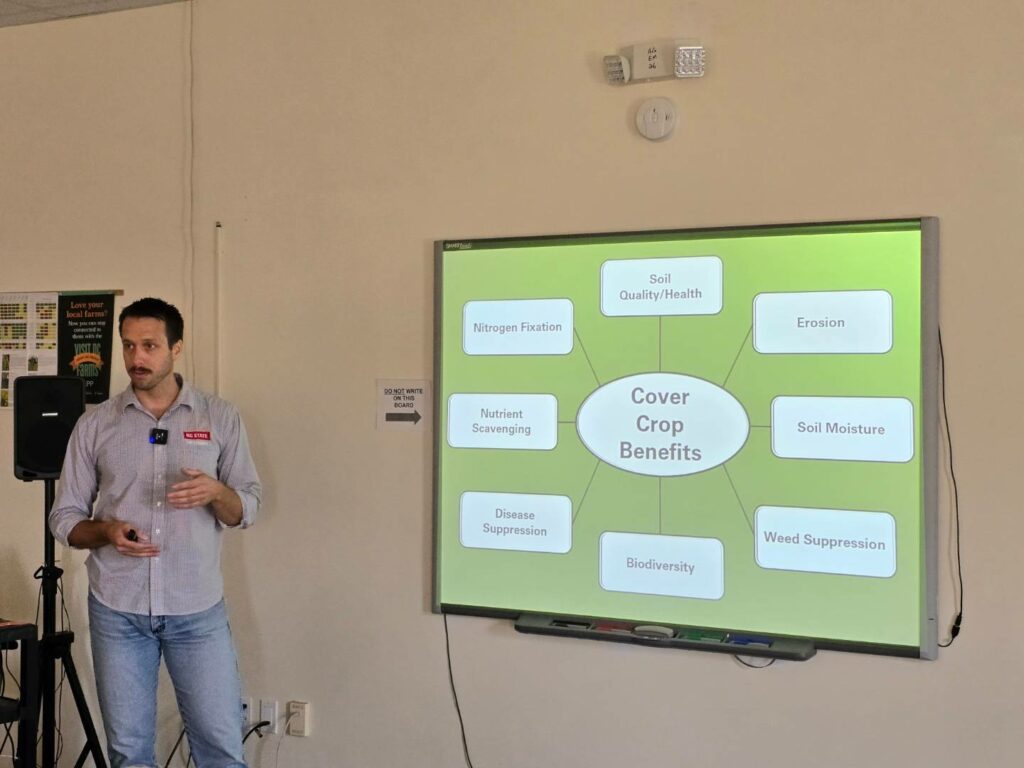Want to Venture Into Cover Cropping? Define Personal Goals for Practice First
go.ncsu.edu/readext?1015178
en Español / em Português
El inglés es el idioma de control de esta página. En la medida en que haya algún conflicto entre la traducción al inglés y la traducción, el inglés prevalece.
Al hacer clic en el enlace de traducción se activa un servicio de traducción gratuito para convertir la página al español. Al igual que con cualquier traducción por Internet, la conversión no es sensible al contexto y puede que no traduzca el texto en su significado original. NC State Extension no garantiza la exactitud del texto traducido. Por favor, tenga en cuenta que algunas aplicaciones y/o servicios pueden no funcionar como se espera cuando se traducen.
Português
Inglês é o idioma de controle desta página. Na medida que haja algum conflito entre o texto original em Inglês e a tradução, o Inglês prevalece.
Ao clicar no link de tradução, um serviço gratuito de tradução será ativado para converter a página para o Português. Como em qualquer tradução pela internet, a conversão não é sensivel ao contexto e pode não ocorrer a tradução para o significado orginal. O serviço de Extensão da Carolina do Norte (NC State Extension) não garante a exatidão do texto traduzido. Por favor, observe que algumas funções ou serviços podem não funcionar como esperado após a tradução.
English
English is the controlling language of this page. To the extent there is any conflict between the English text and the translation, English controls.
Clicking on the translation link activates a free translation service to convert the page to Spanish. As with any Internet translation, the conversion is not context-sensitive and may not translate the text to its original meaning. NC State Extension does not guarantee the accuracy of the translated text. Please note that some applications and/or services may not function as expected when translated.
Collapse ▲Cover crops are plants that are grown to protect soil surfaces in between seasons. The practice of cover cropping continues to gain popularity with the total acres of cover crops planted in the USA increasing by 17% between 2017 and 2022 from 15.4 million to 18.0 million acres. As more farmers turn to this practice, NC State University Extension Agent for Conservation Agronomy Austin Menker has some advice. He has urged farmers who want to adopt cover crops to define the personal goals they hope to achieve with the practice before venturing into it.
Speaking on Monday, June 10 at an engagement with farmers at the N.C. Cooperative Extension Franklin County Center, Menker also urged farmers who are new to cover crops to find local mentors that they can learn from. “I think there’s two really important first steps if you’re new to this. You need to really define your own goals with cover crops. What are you trying to get out of them for your farm? That’s gonna guide your management,” he said.
“I also strongly recommend finding mentors; other growers in your area that have utilized cover crops. Learn from them, bounce ideas off of them. Ideally the more localized to you, the better. There’s a ton of variabilities that influence success and challenges with cover crops. A lot of them are going to be dependent on your specific location,” he added.

Extension Agent for Conservation Agronomy Austin Menker speaks to farmers at N.C. Cooperative Extension Franklin County Center
The discussion with the farmers covered, among others, the benefits and challenges of using cover crops. Menker noted cover crops could help increase soil organic matter, protect soil from water and wind erosion, enhance infiltration and water holding capacity, and reduce runoff and evaporation. They could also help suppress weeds by serving as a physical barrier, and/or competing with weeds for resources. Some cover crops also release allelopathic chemical compounds that can kill weeds. Cover crops could also enhance soil biodiversity by increasing carbon for soil microbial activity and providing a habitat for insects. It can additionally enhance soil aggregation, and improve nutrient recycling and availability.
Menker however noted there are challenges and trade-offs associated with growing cover crops which farmers have to find a way to navigate. The biggest challenge is cost as cover cropping practices will require additional resources to implement. Available labor to grow and terminate cover crops could also be a major challenge. Additionally, available time to terminate cover crops before planting the following season could prove to be a challenge. Also, cover crops could serve as a green bridge that habors pathogens and pests which could stay in the field and be passed on from one season to the next. Also, cover crops could get out of control and become weeds by themselves. Sometimes, cover crops could draw soil moisture during dry seasons. But Menker says these challenges can dealt with if farmers develop a management strategy that works best for them.


